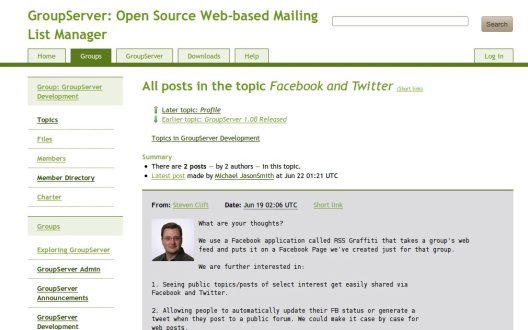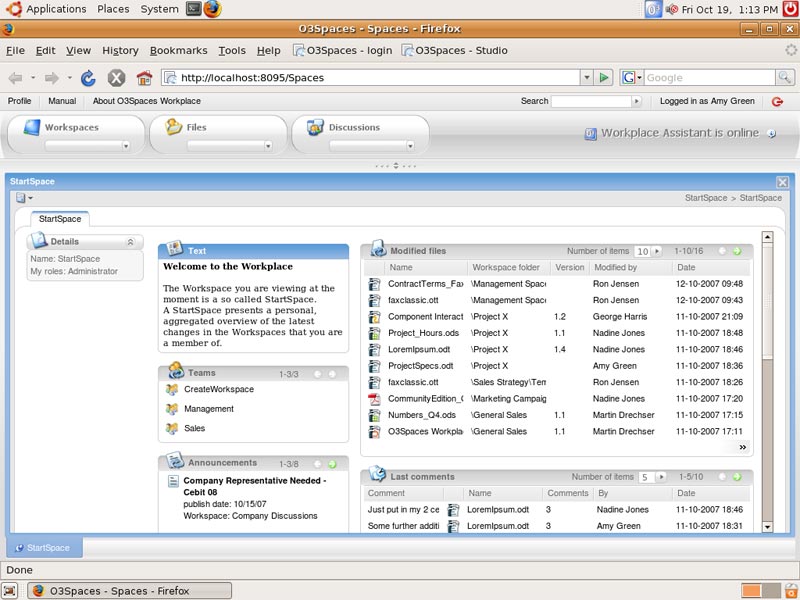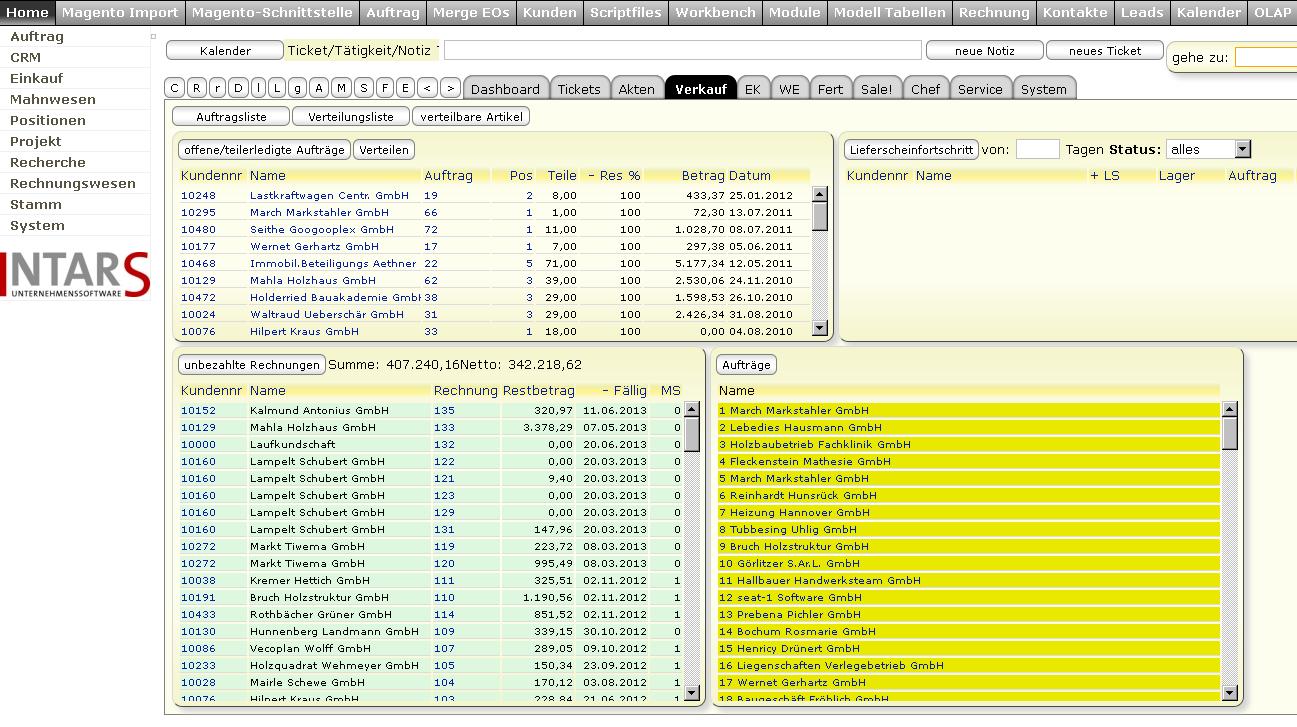GroupServer is a GPL open source collaboration server. GroupServer supports many-to-many interaction in groups and communities via email and an integrated web forum interface.
Websites supported by GroupServer provide a secure, personalised content structure with member directories, postings by topic, RSS and e-mail digest modes, document sharing, and web-based forum management.
GroupServer renders XML content dynamically using XSLTs and is built on Zope and written in Python.
GroupServer is designed and developed by GroupSense, IOPEN and ZYPE.
Here are some key features of "GroupServer":
Participant Features
Logging in:
- participants can change their own password once they are logged into a site
- log me in automatically - when logging in, a participant can choose to have the system log them in automatically when they return using the same computer, until they explicitly log out; this is very useful when clicking links in post footers
- a Site Administrator can set up participant accounts with their initial password blank - the site then reminds these participants to set a password for themselves, every time they log in, until they have set one
- "Login Name and Password Reminder" feature emails a participant's login name and password to the email addresses they have specified on the site (participant can obtain this by entering either their login name or one of their email addresses)
- "create an account" feature with email confirmation
- e-mail subscription without requiring web login (with or without a time-limit for adding a profile, thereby creating a 'full account')
- means of obtaining agreement to "participation protocol" when people join groups (whether by email or the web)
- "welcome message" automatically sent to member when they join a group
Participant Information:
- content can contain a list of people that the user is in groups with (all other participants can be hidden or visible) with links to the other participants' profiles
- each person's Participant Details page displays a bio, the email addresses that the participant chooses to display, an optional photo and a list (with links) of the groups that the participant is a member of
- Participants can modify their bio, change their password, and specify the email addresses that they wish to use to send/receive Online Group posts
- new participant information fields such as Location, Neighborhood/Township/Parish/Village, City/Local Authority, County/Region, State/Province, Country, Personal Website/Weblog URL, Title, Organization/Company, Organization Website URL, IM/Skype ID
- participant photo - each participant's profile page can displays a photo; a participant can upload their own photo; using the "back end" management interface, an administrator can upload paricipant photos in bulk
- hide email address - each participant can determine whether their email address is visible to other logged-in participants (non-logged in participants can never see email addresses unless they are in the text of a post)
- request contact - if a participant has their email address hidden, other logged-in participants can request contact using a feature which sends an email to the requestee with the email address of the requester and a message to say they request contact
Group Features
Email Groups
- Email groups are the primary application that is implemented in the GroupServer framework. Our design goal is email groups that work exceptionally well using both email and the web.
- Email Groups enable people to use ordinary email for group collaboration. All emails generated by the group are stored in a central location so that no individual has to organise or even keep the emails. People can participate in group conversations using only email, if they wish emails can simply be deleted, because each email clearly signals "who is doing what" without even being opened.
Messages Area
- All posts that are made using a GroupServer group are stored in an online Messages Area.
- "Topic" view - the default view in the Messages area shows all posts with the same subject line in a single page; this makes it easy to follow an entire conversation topic, reading each post in chronological order; when posting gets busy, this means that a group can have multiple concurrent conversation topics that are easy to follow. The Topic view shows a photo of the person who made each post, if they have uploaded one.
- Posts view - GroupServer also shows individual posts in date order; each post has a link to the Conversation that it is part of
- HTML email - encoding is removed from HTML email so that it renders as plain text
- Post-folding - the "Topic" view automatically trims excessive bottom quoting and provides an option to display the entire post; this feature is based on a number of heuristics, so it can detect quoting with minimal false positivies, even if a standard convention is not used
- clickable urls - urls and strings beginning with "www." are rendered as clickable links
- masked email addresses - email addresses in the text of posts are diguised using "address (at) domain" format to reduce detection by spambots
- alternate post-shading - the Topic view shows alternate posts shaded to differentiate them clearly
- own post-highlighing - the Topic view highlights a logged-in participant's own posts to differentiate them clearly
- RSS option the list of current topics from each group is available via RSS
Message Processing
- GroupServer has a variety of features that enable reliable message and configurable processing.
- configurable subject line tag - each GroupServer group has a configurable subject line prefix (tag)
- configurable headers and footers - each GroupServer group can either use a site-wide footer or have its own footer; footers can include plain text and dynamically generated links to:
- the home page of the group
- the profile page of the person who made the post
- the "topic" in the messages area that the post is a part of
- configurable reply-to - each group can be configured to address the "reply-to" field to either the sender or the group
- announcement and "service-centre" groups - GroupServer groups can be configured as announcement groups where only selected participants can post or as "service-centre" groups where non-members can post
- attachment-handling - GroupServer can be configured to remove all message attachments; when an attachment is removed, the sender of the message is sent an email notifying them that it has been removed and suggesting that they post the file to the files area
- HTML email - when GroupServer is configured to remove message attachments, it also converts HTML email to plain text before forwarding it to the group members (the HTML version of an email is sent as an attachment); though some people perceive this as a limitation, it ensures that the message forwarded by email looks like the copy in the Messages area (which also has no HTML formatting); it is possible to have GroupServer send a notification each time an HTML email has been converted to plain text
- bounce-handling - GroupServer tracks unsuccessful delivery of emails and notifies the participant using any other email addresses they have specified for themselves; after a configurable number of attempts (intended to prevent the user being disabled prematurely), GroupServer suspends delivery to the bouncing address; the participant can re-enable it using their "email settings"
- configurable email delivery - each participant can specify multiple email addresses that they can post with; an "email settings" interface enables them to select one or more of their addresses for email delivery for each group that they are a member of or they can choose to receive a "topic digest" or no email delivery at all
- email loop handling - GroupServer identifies and terminates "Out of Office" reply loops; the loop-detection uses a variety of configurable methods to recognise automatically generated email
- Post-Limiting - GroupServer allows the Group Administrator to set a limit on the number of posts that each participant can make within a specifed period of time (eg 2 posts per 24 hours)
- "topic digest" mode - each participant can choose to receive a list of the topics that have recently been posted to; for each topic, the digest lists the title (ie subject line), the number of posts, the number of posts in the last 24 hours and the date of the last post and provides a link to the topic in the Messages area (this example shows the Topic Digest for "Exploring GroupServer" from 29 September 2005)
- Moderation - a Group Administrator can moderate a single user or a sub-group of users within a group
Shared Files Area
- Each GroupServer group has a shared files area where group members can post and access files and organise them into folders.
- profile page links - each file has a link to profile page of the person who uploaded it
- descriptions - files have a description and link to the person who uploaded it
- folders - files can be organised into folders
- permissions - the files area can be made visible to members only or to non-members; usually only members can add files or folders and delete the ones they have added
Site Features
Flexible Site Structure
- One GroupServer installation can support multiple sites. Each of those sites can have its own domain (url) for both Web and email. Each site has its own CSS (ie interface design, look and feel) and its own users and groups. They function as entirely independent sites but for administration purposes, many tasks only need to be done once to be available to all sites.
- Each site on a GroupServer installation can have one or more "divisions". In cases where a single site supports separate communities of users, each community of users can log into their own division and have a unique view of the site. This feature is used at the ABEL eCampus where the participants use the site in discrete cohorts. Where there are participants who are in more than one division. GroupServer can provide a "division-switcher" that enable people to navigate from one division to the next. This is useful for ABEL staff who oversee all the divisions on the eCampus.
- It is also possible to create a "Virtual Site" that is actually a division. A Virtual Site can have its own domain for Web and email, its own groups and its own CSS (interface design). The user accounts, however relate to the actual site ie are (subject to permissions) common to the other divisions on the site (whether they are virtual sites or not). This GroupServer site is a virtual site. Virtual sites are easier to administer than 'actual' sites as they share a lot of common infrastructure.
Other Site Features
- Personalisation:
- all site content can be personalised to a group or individual
- Customisable Look and Feel:
- site layout, fonts format and styling can be customised to meet individual requirements
- Accessible with Ordinary Email and Web Browser:
- no specialised software is required by participants
- Social Orientation:
- all site content and features are organised to support the groups and communities that people work and learn in
- Online Groups can be hidden (so only the group members can see the existence of the group), visible (with public and private areas), or open (non-members can see all areas of the group)
- Structured Content:
- GroupServer sites can include content such as News Items and Content Libraries (links, files, articles)
- all GroupServer content is stored in standards-compliant structure (currently RSS and working towards DocBook) and can be rendered as HTML or PDF
- Surveys:
- surveys can be created for participant surveys, polls or gathering feedback
- question-types can include yes/no, likert scale, choose one item from a list, choose one or more items from a list, text, comment or numeric
- questionnaires can be web-based or generate a paper-based questionnaire (PDF) and web data-entry form
- GroupServer automatically generates reports on survey results (PDF format)
- Data-Based Content:
- GroupServer can display database generated content such as assessment results, invoices or participant photo-sheets
- database generated content can be displayed as HTML or dynamically generated PDF in customised print-oriented formats
- Search:
- the GroupServer Search feature find search text in messages files (descriptions only - search of file contents to be implemented) of the specific groups that each participant has access to (search of static content and participant information is in the pipeline)
Administration Features
Group Administration Features
- A Division Administrator (see below) is able to appoint a Group Administrator (who is not necessarily a member of the group). The purpose of the Group Administrator role is to enable someone to manage the running of an online group within the structure that was set up when the group was created (without being able to change that structure).
- A Group Administrator is able to:
- create new user accounts
- join users to the group
- remove users from groups
- ban members from groups
- remove files and folders from the Files area
- enable and manage Moderation of a group
Division Administration Features
- A "Division Administrator" can create and remove online groups, configure their properties and appoint "Group Administrators". Division Administrators have all the abilities that Group Managers do.
- In addition, a Division Administrator is able to:
- determine the visibility of the group and its Messages and Files area
- determine whether the group can be joined by anyone without approval or only by invitation
- enable restrictions to the frequency of posts
- define the name, purpose, membership and other statements that appear on the group's "Charter" page
Requirements:
- Python
- libxml/libxslt
- Apache
- Postfix
What is new in this release:
- This version adds improvements to groups, profiles, and the site homepage, and steps towards easier installation.
What is new in version 11.08:
- It is now possible to signup using Facebook.
- A number of other signup related improvements were made.
What is new in version 11.05:
- An update to the Start a Group system so the system administrator is made the group administrator [4].
- When an email address is verified it is made the preferred delivery address if the user has no other preferred delivery addresses [5].
- The list of files that are associated with a post are more clearly demarcated from the body of the message [6].
- Long URLs no longer word-wrap in the body of posts [7].
- Zope has been updated to 2.3.6 [8]. This may cause problems with some configurations, as IPv6 support is now present.
What is new in version 11.04:
- Support for post hiding and assorted bugfixes.
What is new in version 11.03:
- The "change email settings" page was updated.
- Searching now searches the topic and post titles.
- An "edit this page" link is shown to logged out users on editable pages. "accept invitation" page UI improvements were made.
What is new in version 10.10:
- New Group Homepage:
- The homepage used by groups has had a major redesign [3]. Now it is divided into multiple tabs. This allows for information to be better organized, and more easily found. Overall the look is cleaner, and the page is easier to use.
- Better Bouncing:
- Sometimes an email to a group member will not get through, and the message bounces. GroupServer has always recorded these bounces. Now this information is presented to the group administrator, who can see a log of failed attempts to send the member an email message [4].
- Resend Invitation:
- The group administrator now has the option of resending an invitation that did not get through to the new group member [5]. There have been many other minor improvements to the invitation system thanks to the feedback from the users of OnlineGroups.Net.
- Notification Updates:
- The email notifications that are sent out by GroupServer in response to an event have been given a through update. They are now clearer and contain more useful information than before [6].
- New Favicon:
- GroupServer now has a new multi-resolution favicon, which is shown in the location bar of the browser [7].
- New Help System
- The user manual and administration manuals are out of date and in need of work. To help with this a new help system has been introduced [8]. It allows for sections of the manuals to be more easily maintained, which will hopefully allow for better manuals in the future.
- Switch to Zope 2.13 Beta:
- GroupServer now runs on the the latest version of Zope 2. The new features in Zope are used for the new group homepage, and the new help system.
- Footnotes:
- The tickets in GroupServer 10.10 - Gelato while Viewing the Sights detail what has changed in this release.
- The changes that are planned for GroupServer 10.11 - Kulfi Craved while Caving are detailed in the tickets
- The details of the new group homepage is available in the Group Homepage Rebuild topic in GroupServer Development. Deploying the new homepage closes Ticket 426 and a slew of sub-tickets.
- Showing a log of the failed attempts to send a message closes Ticket 15 and Ticket 509.
- Allowing administrators to reissue an invitation closes
What is new in version 10.09:
- A major overhaul of group invitations, as well as join and leave.
- Management of members has been overhauled at the infrastructure level.
- The addition of a new sharing mechanism for linking posts to social media.
- The site introduction has been tweaked to use a WYSIWYG editor.
- A change to the release numbering convention.




Comments not found